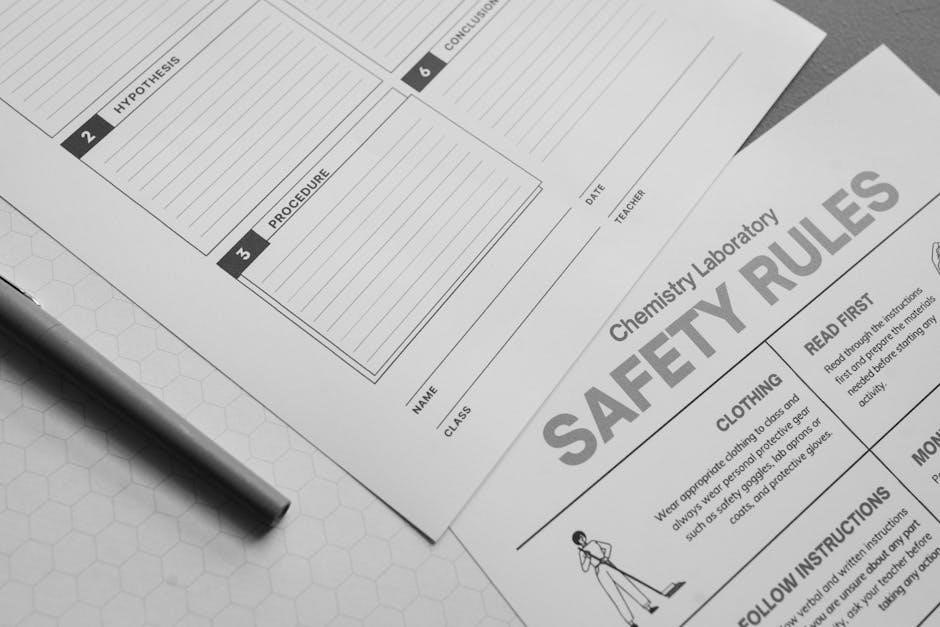The Glannon Guide to Civil Procedure is a comprehensive resource designed to aid law students and practitioners in mastering civil procedure through multiple-choice questions and analysis.
1.1 Purpose and Significance of the Guide
The Glannon Guide to Civil Procedure is designed to help law students and practitioners master civil procedure through engaging multiple-choice questions and detailed analysis. Its purpose is to simplify complex legal concepts, making them accessible and easy to understand. The guide serves as a valuable supplement to classroom instruction and a reliable tool for exam preparation. By focusing on practical application and real-world scenarios, it equips users with the skills to analyze and apply civil procedure principles effectively in various legal contexts.
1.2 Overview of Civil Procedure Concepts
The Glannon Guide to Civil Procedure provides a clear overview of key concepts, including jurisdiction, pleading, motions, discovery, trials, and post-trial procedures. It breaks down complex topics into manageable sections, offering practical examples and multiple-choice questions to reinforce understanding. The guide covers foundational principles and modern applications, ensuring a comprehensive grasp of civil procedure. Its structured approach helps users navigate the subject systematically, making it an invaluable resource for both students and legal professionals seeking to master civil procedure concepts effectively.
1.3 Structure and Organization of the Guide
The Glannon Guide to Civil Procedure is organized around multiple-choice questions and detailed analysis, providing a user-friendly approach to learning. Each chapter focuses on specific topics, such as jurisdiction, motions, and trials, with clear introductions and explanations. The guide uses a conversational tone to break down complex concepts, making it accessible to students and practitioners. Its structured format aligns with current legal standards, ensuring a thorough understanding of civil procedure principles and their practical applications.

Author Background: Joseph W. Glannon
Joseph W. Glannon is a renowned legal scholar and educator, combining academic expertise with practical experience. His work bridges complex legal concepts for students and practitioners.
2.1 Biography and Academic Contributions
Joseph W. Glannon is a distinguished legal scholar and educator, earning his B.A., M.A.T., and J.D. from Harvard. He clerked for the Massachusetts Appeals Court and served as Assistant Corporation Counsel for Boston before joining Suffolk University Law School in 1980. Glannon teaches Civil Procedure, Conflict of Laws, and Torts, and has written extensively on public tort liability in Massachusetts.
His academic contributions include authoring Civil Procedure: Examples & Explanations and The Glannon Guide to Civil Procedure, both widely used by law students. He also co-authored a leading Civil Procedure casebook and an online video review program, making complex legal concepts accessible and engaging for learners.
2.2 Teaching Philosophy and Approach
Joseph W. Glannon’s teaching philosophy emphasizes engaging students through an interactive and practical approach. He combines rigorous academic insight with real-world examples, making complex legal concepts accessible. Glannon’s method includes multiple-choice questions, conversational explanations, and relatable hypotheticals to foster active learning. His uniquely entertaining style, blending humor and clarity, helps students grasp civil procedure effectively. This approach not only enhances understanding but also prepares learners for exam success and practical application in legal practice.
2.3 Other Notable Works by Glannon
Joseph W. Glannon is renowned for his contributions to legal education beyond the Glannon Guide. He authored Civil Procedure: Examples & Explanations, now in its Ninth Edition, and The Law of Torts: Examples & Explanations, in its Sixth Edition. Glannon also co-authored Civil Procedure: A Coursebook and created the online video series Practice Perfect Civil Procedure. These works reflect his commitment to making complex legal concepts accessible and engaging for students and practitioners alike.

Key Features of the Glannon Guide
The Glannon Guide features multiple-choice questions, practical examples, and a conversational tone, making complex civil procedure concepts accessible and engaging for effective learning and exam preparation.
3.1 Multiple-Choice Questions and Analysis
The Glannon Guide features multiple-choice questions that cover key civil procedure topics, providing in-depth analysis to help students understand and apply legal concepts effectively. These questions simulate exam scenarios, enabling learners to test their knowledge and critical thinking skills. The detailed explanations guide students through correct and incorrect answers, reinforcing understanding and preparation for legal exams. This interactive approach ensures practical application of civil procedure principles, making complex topics more accessible and engaging for law students and practitioners alike.
3.2 Practical Examples and Hypotheticals
The Glannon Guide incorporates practical examples and hypotheticals to illustrate key civil procedure concepts, making them more relatable and easier to understand. These real-world scenarios help students apply theoretical knowledge to actual legal situations, fostering a deeper grasp of the subject. The guide’s engaging examples are designed to clarify complex topics, such as jurisdiction, motions, and discovery, through straightforward and accessible language, ensuring students can connect legal principles to practical applications effectively.
3.3 Conversational Tone and Accessibility
The Glannon Guide is renowned for its conversational tone, making complex civil procedure concepts approachable and engaging. The guide uses clear, straightforward language to explain difficult topics, ensuring accessibility for all learners. This approachable style helps students grasp and retain information more effectively, reducing anxiety and fostering confidence in understanding the material. The guide’s readability is a key feature, making it an invaluable resource for both law students and practitioners seeking to refine their knowledge of civil procedure.

Target Audience
The Glannon Guide to Civil Procedure is designed for law students, practicing attorneys, and individuals engaged in self-study or exam preparation, serving as a valuable supplement to classroom lectures.
4.1 Law Students and Civil Procedure Courses
The Glannon Guide to Civil Procedure is specifically tailored for law students, providing a clear and engaging approach to understanding complex legal concepts. It uses multiple-choice questions and practical examples to simplify topics like jurisdiction, pleading, and motions. The guide’s conversational tone and structured format help students apply legal principles effectively. Designed as a supplement to coursework, it reinforces key concepts and aids in exam preparation, making it an essential resource for first-year civil procedure courses.
4.2 Practicing Attorneys and Legal Professionals
The Glannon Guide to Civil Procedure is also an invaluable resource for practicing attorneys seeking to refresh or deepen their understanding of civil procedure. Its practical examples and multiple-choice questions provide a quick yet comprehensive review of key concepts. The guide’s clear explanations and conversational tone make it accessible for legal professionals needing to stay updated on procedural rules and strategies. It serves as a handy reference for applying legal principles in real-world scenarios and exam preparation.
4.3 Self-Study and Exam Preparation
The Glannon Guide to Civil Procedure is an excellent tool for self-study and exam preparation, offering multiple-choice questions and detailed analyses. Its conversational tone and practical examples make complex concepts accessible. Students can use it to supplement classroom learning or as a standalone study aid. The guide’s focus on application helps learners understand how to approach exam questions confidently. It is particularly effective for reviewing key principles and reinforcing understanding of civil procedure rules and practices.

Pedagogical Approach
The Glannon Guide employs multiple-choice questions, practical examples, and a conversational tone to engage students. Its interactive approach promotes active learning, application of concepts, and reinforcement of key principles effectively.
5.1 Active Learning Through Questions
The Glannon Guide fosters active learning by presenting multiple-choice questions that simulate exam scenarios, encouraging students to engage deeply with civil procedure concepts. Each question is followed by detailed analysis, explaining correct and incorrect answers, and highlighting key principles. This interactive approach helps students develop critical thinking skills, apply legal rules to factual situations, and identify areas for further study. The question-and-analysis format mirrors real-world problem-solving, making complex topics more accessible and preparing students for both classroom and professional challenges effectively.
5.2 Application of Legal Concepts
The Glannon Guide emphasizes the practical application of legal concepts through real-world scenarios and hypotheticals. By presenting multiple-choice questions and explanations, it helps students connect abstract legal theories to tangible situations. This approach enables learners to understand how civil procedure rules operate in practice, making complex concepts more relatable and easier to retain. The guide’s focus on application ensures that students can apply what they learn to actual legal problems, preparing them for both exams and future legal practice effectively.
5.3 Reinforcement of Key Principles
The Glannon Guide reinforces key principles through repetitive exposure to fundamental concepts, ensuring a deep understanding of civil procedure. Multiple-choice questions and detailed analyses help solidify learning, while practical examples and hypotheticals provide context. The guide’s conversational tone makes complex topics approachable, allowing students to grasp and retain essential principles. This methodical reinforcement enables learners to master foundational concepts and apply them confidently in legal analysis and problem-solving scenarios.

The Glannon Guides Series
The Glannon Guides Series offers comprehensive study aids across various legal subjects, providing multiple-choice questions, practical examples, and clear explanations to enhance understanding and application of key concepts.
6.1 Overview of the Series
The Glannon Guides Series is a collection of study aids designed to help law students and professionals master complex legal topics through interactive and engaging methods. Each guide focuses on specific areas of law, such as civil procedure, torts, and evidence, using multiple-choice questions, practical examples, and clear explanations to reinforce understanding. The series is known for its conversational tone, making dense legal concepts accessible and easier to apply in real-world scenarios. By breaking down material into manageable sections, the guides support active learning and exam preparation, catering to both classroom supplementation and self-study needs.
6.2 Other Titles in the Series
Beyond the Glannon Guide to Civil Procedure, the series includes titles like Civil Procedure: Examples & Explanations and The Law of Torts: Examples & Explanations. These resources provide in-depth analysis of specific legal areas, using a combination of multiple-choice questions, practical examples, and clear explanations. The series is designed to make complex legal concepts accessible, offering tools for both students and practitioners to enhance their understanding and application of the law in real-world scenarios.
6.3 Unique Benefits of the Series
The Glannon Guides series offers unique benefits, including its engaging, conversational tone and practical examples that simplify complex legal concepts. The series provides multiple-choice questions with detailed analyses, helping users master exam preparation and real-world application. Its accessible format makes it an ideal supplement to classroom learning, while its focus on active learning ensures retention of key principles. These features collectively create a user-friendly resource that bridges the gap between academic study and practical legal skills.

Editions and Updates
The Glannon Guide to Civil Procedure is now in its Fourth Edition, offering updated multiple-choice questions and analyses aligned with current legal standards and practices.
7.1 Latest Edition Features
The Fourth Edition of the Glannon Guide to Civil Procedure features updated multiple-choice questions and detailed analyses, ensuring alignment with current legal standards and practices; New practice questions address emerging issues in civil procedure, while revised explanations provide clarity on complex topics. The edition incorporates feedback from students and practitioners, enhancing its practical relevance. Additional hypothetical scenarios aid in applying legal concepts to real-world situations, making it an indispensable tool for both academic and professional settings.
7.2 Revisions and Improvements
The latest edition of the Glannon Guide to Civil Procedure includes significant revisions to enhance clarity and relevance. Updates reflect recent changes in federal rules and procedures, ensuring students and practitioners stay current. New questions and explanations address emerging topics such as e-discovery and virtual hearings. The guide also features improved organization, with streamlined content for better readability. These revisions strengthen its effectiveness as a study aid, making complex concepts more accessible and practical for learners at all levels.
7.4 Alignment with Current Legal Standards
The Glannon Guide to Civil Procedure is meticulously updated to align with the latest federal rules and procedural changes. It incorporates recent developments in civil procedure, ensuring users grasp current legal standards. Topics such as e-discovery, virtual hearings, and updated rules of evidence are prominently featured. This alignment ensures that students and practitioners can apply the guide’s teachings to real-world scenarios, staying abreast of evolving legal practices and maintaining compliance with contemporary judicial expectations.

Topics Covered in the Guide
The Glannon Guide to Civil Procedure covers essential topics such as jurisdiction, pleading, motions, discovery, trials, and post-trial procedures, providing a comprehensive overview of civil procedure.
8.1 Jurisdiction and Venue
The Glannon Guide thoroughly explores jurisdiction and venue, addressing subject matter jurisdiction, personal jurisdiction, and venue requirements. It provides clear explanations and practical examples to help students understand these foundational concepts. The guide includes multiple-choice questions and analysis to test comprehension of jurisdictional principles. Real-world scenarios illustrate how jurisdictional issues arise and are resolved in practice. This section ensures a solid understanding of where and how lawsuits can be properly brought, aligning with current legal standards and procedures.
8.2 Pleading and Procedure
The Glannon Guide dedicates a section to pleading and procedure, covering essential concepts like notice pleading, federal rule requirements, and the importance of proper complaint drafting. Practical examples and hypotheticals illustrate how pleadings shape litigation outcomes. Multiple-choice questions test understanding of pleading standards and procedural timelines. The guide emphasizes clarity and precision in pleadings, ensuring students grasp how to draft effective complaints and responses. This section bridges legal theory with practical application, making complex pleading rules accessible and manageable for learners.
8.3 Motions and Discovery
The Glannon Guide thoroughly explores motions and discovery, explaining their strategic importance in shaping litigation. It covers dispositive motions, such as motions to dismiss and summary judgment, as well as discovery tools like interrogatories and requests for production. Practical examples and multiple-choice questions help students master procedural rules and tactical considerations. The guide emphasizes understanding Federal Rules of Civil Procedure and how to apply them effectively in real-world scenarios, ensuring a strong grasp of pre-trial practices and evidentiary foundations.
8.4 Trials and Judgment
The Glannon Guide provides a detailed analysis of trials and judgment, focusing on the procedural aspects of jury trials, evidence presentation, and the entry of judgments. It explores post-verdict motions, such as judgments as a matter of law and motions for a new trial, ensuring students understand how to navigate the final stages of litigation. Practical examples and questions clarify the Federal Rules of Civil Procedure, helping learners grasp the practical application of trial procedures and judgment enforcement.
8.5 Post-Trial Procedures
The Glannon Guide thoroughly addresses post-trial procedures, including motions for new trials, judgments as a matter of law, and claim preclusion. It explains the processes for enforcing judgments and the finality of rulings. Practical examples and analysis clarify complex concepts, such as the grounds for reopening cases or appealing decisions. This section ensures learners understand the procedural steps following trial, emphasizing the importance of these mechanisms in achieving justice and resolving disputes effectively.

Practical Applications
The Glannon Guide bridges theory and practice, offering real-world scenarios, strategic considerations, and ethical implications to help students and practitioners apply civil procedure concepts effectively.
9.1 Real-World Scenarios and Examples
The Glannon Guide incorporates real-world scenarios and examples to illustrate key civil procedure concepts, making complex topics more relatable and easier to understand. These practical examples, often presented through multiple-choice questions, simulate actual legal challenges, allowing learners to apply theoretical knowledge in realistic contexts.
By focusing on jurisdictional disputes, motions practice, and trial procedures, the guide helps students and practitioners navigate real-life legal situations with confidence, ensuring they can identify and address procedural issues effectively in actual cases.
9.2 Strategic Considerations for Practitioners
The Glannon Guide provides practitioners with strategic insights to navigate complex procedural issues effectively. By analyzing real-world scenarios and multiple-choice questions, it helps practitioners make informed decisions, such as when to file motions or how to approach discovery. The guide emphasizes practical application, enabling attorneys to anticipate and address potential pitfalls in litigation. This focus on strategic considerations ensures that practitioners can apply the concepts learned to real cases, enhancing their procedural acumen and courtroom readiness.
9.3 Ethical Implications in Procedure
The Glannon Guide emphasizes the ethical dimensions of civil procedure, ensuring practitioners understand the importance of honesty, fairness, and transparency. It highlights the duty to avoid frivolous claims and motions, while also addressing issues like candor to the court and client representation. The guide underscores the consequences of unethical conduct, such as sanctions, and provides guidance on maintaining professional integrity throughout legal proceedings. This focus on ethics ensures that procedural practices align with legal and moral standards.

Impact on Legal Education
The Glannon Guide has significantly influenced legal education by providing clear, engaging resources that enhance student understanding and success in civil procedure courses nationwide.
10.1 Student Feedback and Success Stories
Students widely praise the Glannon Guide for its clarity and effectiveness. Many report improved understanding and performance in civil procedure courses. One student shared, “I used the Glannon Guide and earned an A in my class!” The guide’s engaging style and practical examples have helped numerous learners grasp complex concepts. Feedback highlights its value as both a study aid and exam preparation tool, making it an indispensable resource for legal education. Its impact is evident in students’ success stories nationwide.
10.2 Adoption in Law Schools
The Glannon Guide to Civil Procedure is widely adopted in law schools nationwide. Its clear explanations and practical approach make it a favorite among faculty. Many law schools integrate the guide into their civil procedure courses, praising its ability to simplify complex concepts. The guide’s popularity stems from its alignment with course materials and its effectiveness in preparing students for exams. Its adoption reflects its reputation as a trusted resource in legal education, now in its Fourth Edition.
10.3 Contribution to Legal Scholarship
Joseph W. Glannon’s works, including the Glannon Guide, have significantly contributed to legal scholarship. His “Civil Procedure: Examples & Explanations” and “The Glannon Guide to Civil Procedure” are seminal texts. These resources provide clear, engaging explanations of complex legal concepts, making them invaluable for both students and educators. Glannon’s approach, combining multiple-choice questions with detailed analysis, has set a standard in legal education. His contributions have shaped how civil procedure is taught and understood, influencing generations of legal scholars and practitioners.
The Glannon Guide to Civil Procedure is a trusted resource, offering a clear and engaging approach to mastering civil procedure through multiple-choice questions and practical examples.
11.1 Summary of Key Points
The Glannon Guide to Civil Procedure is a trusted study aid offering multiple-choice questions, practical examples, and a conversational tone to simplify complex legal concepts. Designed for law students and practitioners, it covers essential topics like jurisdiction, motions, and trials. The guide emphasizes active learning, application of legal principles, and exam preparation. Its structured approach and accessible explanations make it an invaluable resource for understanding civil procedure, aligning with current legal standards and providing a comprehensive review for academic and professional success.
11.2 Final Thoughts on the Guide’s Value
The Glannon Guide to Civil Procedure stands out as an indispensable resource for legal education, offering a unique blend of multiple-choice questions, practical examples, and clear explanations. Its conversational tone and focus on active learning make complex concepts accessible. Whether for exam preparation or professional development, the guide provides unparalleled clarity and depth. Its ability to engage users and simplify civil procedure ensures it remains a cornerstone for law students and practitioners seeking to master this critical area of law effectively.
11.3 Recommendations for Use
The Glannon Guide to Civil Procedure is highly recommended as a supplementary resource for law students and practitioners. Use it throughout the semester to reinforce classroom learning and as a tool for exam preparation. Leverage the multiple-choice questions to test understanding and the practical examples to apply concepts. Its conversational tone makes it accessible, while its focus on key principles ensures comprehensive mastery. Ideal for self-study or as a refresher, the guide is an essential companion for excelling in civil procedure.
Comments